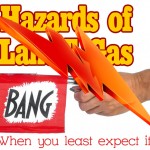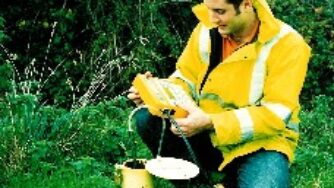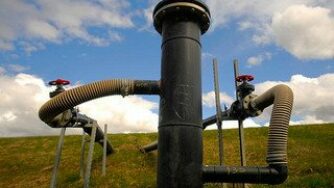Buying Real Estate: Understand Landfill Gas Risks before buying land near a landfill!
The ability of landfill sites to evolve methane has been recognised for very many years by site operators who appeared until the mid-seventies to accept small fires caused by ignition of methane as one of the minor problems associated with waste disposal. Methane problems from landfill gas created by the waste, were of little consequence when sites were small and situated outside the boundaries of towns or villages.
However in recent years there has been great pressure to acquire land for building so that in many instances real estate has been developed close to old and not so old filled and disused landfill sites.
All real estate buyers are recommended to take great care when considering purchase under these circumstances.
Many old landfills have been restored and their sites been incorporated into urban areas. Often such sites are levelled and grassed over to be used for recreational purposes, and indeed this can be a very satisfactory end-use especially as any settlement which occurs can be filled in. However, problems can arise if the landfill gas migrates sideways or upwards, as in the case studies which follow. These examples are quite old – newer ones are hard to come by so no-one like this sort of publicity. Although implementation of preventative measures is now much better and pretty much routinely applied, all those in real estate should be aware of these risks which can still exist today.
Landfill Gas Explosion, Methane Migration and Fires – Case Histories from the USA
Case A – Building explosion Atlanta, Georgia 1967
One of the first explosions thought to involve landfill gas in a building occurred in Atlanta, Georgia in December 1967. Originally the building was constructed with one storey and a basement and the latter was eventually bricked-off thus isolating it. The only connecting passage from the basement to the upper storey was a 6 inch diameter pipe through which a 3 inch gas pipe ran. The gap between the pipes was not sealed. Landfill gas which escaped through the gap was ignited by a cigarette which resulted in an explosion. This completely demolished the building with two people being killed and two suffering serious injury.
Case B – Armoury Winston-Salem, North Carolina methane migration
In 1962 an armoury was built close to an operating landfill in Winston-Salem, North Carolina. The landfill was from 3 to 13 metres deep and during the mid-60's combustible gases accumulated in nearby sewers and minor fires and explosions occurred. In September 1969 an explosion, thought to be caused by smoking, occurred in the building in which 25 people were injured and 3 died. Migration of landfill gas into the building may have been encouraged by the placement of additional cover material on the fill about a week before the incident.
Case C – Branford Landfill, Los Angeles methane migration
In Los Angeles, at the Branford landfill, which was situated in a gravel pit concentrations of methane well above the lower explosive limit were found up to about 150 m from the edge of the fill. Initial attempts to control methane migration by installation of standpipes and trenches were unsuccessful. The reason for the failure is not clear but is probably due to the depth of the site which was considerable.
Case D – Sheldon-Arleta Landfill, Los Angeles
Also in Los Angeles, at the Sheldon-Arleta landfill, similar gas migration problems were encountered to those in case 11. Since the Sheldon-Arleta site is in a residential neighbourhood it was essential to take rapid remedial action. A series of wells 8 m deep, spaced on 50 m centres were-installed just within the landfill boundary. Each well had a designed withdrawal rate of 200 cubic ft/min each and were linked together with the landfill gas being flared off.
This site is of particular interest because it demonstrated that the need to install a gas migration control system and that by so doing landfill gas could be controlled. Thus subsequently gave rise to the present industry based on extraction of landfill gas with subsequent utilisation.
This early experience in California gave impetus to the new technology of landfill gas utilisation for power generation. This is of only passing interest to the real estate buyer, but is important nevertheless as it shows just how much energy is present in the landfill gas, which if not controlled can give rise to explosion potential.
CONTROL OF LANDFILL GAS MIGRATION REMOVES EXPLOSION HAZARDS
The most important step for those considering a real estate purchase is to recognise that if any development is to take place either on or near to a landfill site then problems can occur. In the vast majority of cases planners, architects and developers are normally aware of these risks and measures will have been taken to make the land and properties safe.
The development professional do normally take measures to overcome potential hazards and the real estate purchaser will, having completed suitable research, or having ensured that his or her professional advisers have done this research, find that a negligable risk remains.
There are many ways in which these risks to real estate value are removed. Most frequently special features are incorporated into building designs to reduce explosion risks to acceptably low levels, before these buildings are put up for sale. Nevertheless, good advice dictates that real estate buyers should carry out their own independent checks.
IF DOUBT REMAINS CARRY OUT A REAL ESTATE SITE METHANE SURVEY
If development has taken place in close proximity to landfill, and there is a possibility of methane being present in the ground, or in any part of the real estate property, then a survey of methane concentrations on the site is recommended.
This can be done by drilling boreholes and fitting these with perforated liners and measuring methane concentrations after a few days. A cheaper but in many instances equally satisfactory option, is to dig pits with a mechanical excavator to a depth of 3-4 m, install perforated pipe, back-fill and again measure methane after several days. Measurements of gas concentrations can be made either on site using commercially available instruments such as a Gas Tec or Gas Scope and must be assessed by suitably qualified experts.
The astute real estate buyer will ensure that by understanding landfill gas aspects when buying property near landfills – closed or open – he avoids losses later. It is also possible of course that by heeding this article and carrying out site investigation a true bargain real estate purchase may be possible. Other buyers may simply not be willing to make an offer for such land, which in many cases may be proven by investigation to be landfill gas risk free.
Hazards of Landfill Gas And Risks to Building Development
Understanding the hazards of landfill gas and evaluating the risks in relation to the location and form of building development, is fundamental to arriving at a successful and safe design strategy. The major hazards of landfill gas with respect to building development are summarized as follows: (a) Flammabilily hazards of landfill gas Landfill gas is […]




